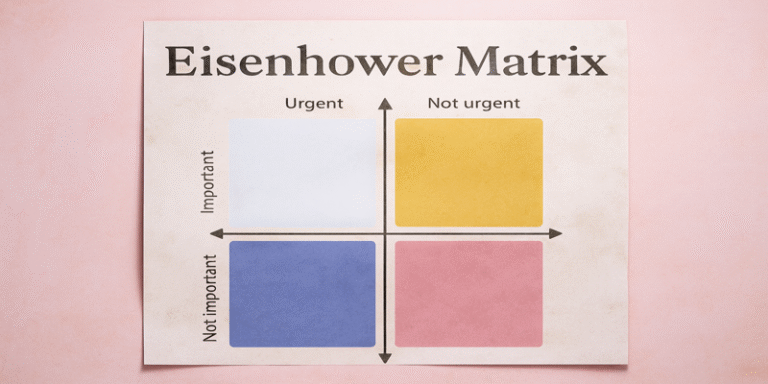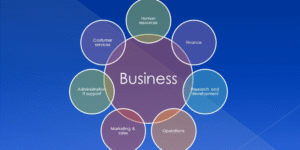In today’s fast-paced professional and academic environments, managing time effectively has become one of the most critical skills for achieving success and maintaining mental well-being. Among the numerous tools and frameworks designed to enhance productivity, the Eisenhower Matrix—also known as the Urgent-Important Matrix—stands out for its simplicity, clarity, and practicality. This framework helps individuals and organisations distinguish between tasks that demand immediate action and those that truly contribute to long-term goals and values.
The Eisenhower Matrix was popularised by Dwight D. Eisenhower, the 34th President of the United States, who was renowned for his disciplined approach to leadership and efficiency. Eisenhower once remarked, “What is important is seldom urgent and what is urgent is seldom important” (Harvard Business Review, 2024). His systematic method of decision-making has since been adopted globally in business management, education, and personal productivity.
1.0 Understanding the Eisenhower Matrix
The Eisenhower Matrix is a decision-making and prioritisation framework that classifies tasks according to two dimensions: urgency and importance. Developed originally as a military decision-making tool, it later gained widespread popularity after being featured in Stephen Covey’s (1989) seminal book The 7 Habits of Highly Effective People. Covey integrated Eisenhower’s principle into his model of personal management, where Quadrant II (important but not urgent) was described as the key to long-term effectiveness.
The matrix divides tasks into four quadrants, each requiring a distinct management approach:
Quadrant I: Urgent and Important – “Do It Now!”
Tasks in Quadrant I are both urgent and important. They demand immediate attention because they directly impact critical goals, deadlines, or crises. These activities often involve pressing issues such as work emergencies, project deadlines, medical situations, or conflict resolution.
For instance, a marketing professional responding to a client crisis before a campaign launch or a student submitting a dissertation minutes before the deadline operates in this quadrant. According to Lakein (1996) in How to Get Control of Your Time and Your Life, these activities are “fire-fighting” in nature and cannot be postponed without negative consequences.
However, operating too frequently in Quadrant I can lead to stress, burnout, and reduced strategic focus (Covey, 1989). Therefore, the goal should be to reduce Quadrant I tasks through better planning and proactive behaviour.
Quadrant II: Not Urgent but Important – “Plan It or Delay It!”
Quadrant II is the most crucial for achieving sustainable success. It consists of tasks that are important but not urgent, meaning they contribute to long-term development, personal growth, and strategic progress. Examples include career planning, skill development, health maintenance, relationship building, and reflective thinking.
As Covey (1989) asserts, highly effective individuals spend the majority of their time in this quadrant because it embodies proactive self-leadership. By dedicating time to activities such as goal setting, learning, and preventive maintenance, individuals reduce future crises, thus decreasing the burden of urgent tasks.
For instance, a company investing in staff training may not see immediate returns but will benefit in the long run through improved performance and retention. Similarly, a student creating a study plan weeks before exams reduces the likelihood of last-minute panic.
According to Mind Tools (2024), focusing on Quadrant II enhances both productivity and satisfaction by promoting deliberate choices aligned with one’s values.
Quadrant III: Urgent but Not Important – “Delegate It!”
Tasks in Quadrant III appear urgent but are not genuinely important. These are interruptions, distractions, or minor requests that demand attention but do not contribute significantly to personal or organisational goals. Examples include unscheduled phone calls, non-essential emails, routine meetings, or administrative errands.
Research by Kaufman (2018) in Harvard Business Review indicates that middle managers spend up to 60% of their day dealing with interruptions, often mistaking them for meaningful work. This creates an illusion of productivity, while in reality, these activities consume valuable time and mental energy.
The recommended approach is to delegate or automate such tasks whenever possible. Modern digital tools such as email filters, scheduling assistants, and task delegation platforms (e.g., Trello, Asana) can streamline these processes. By delegating Quadrant III activities, individuals free up more time for Quadrant II strategic thinking.
Quadrant IV: Not Urgent and Not Important – “Don’t Do It!”
Quadrant IV includes tasks that are neither urgent nor important—essentially, time-wasting activities. These often involve idle entertainment, social media scrolling, gossip, or aimless browsing. While occasional relaxation is beneficial, excessive indulgence in Quadrant IV leads to procrastination and inefficiency.
According to Grant (2019), leisure should be intentional and restorative, not habitual avoidance. In his book Give and Take, Grant argues that meaningful rest enhances creativity and productivity, whereas passive entertainment drains cognitive resources.
To address this, individuals can create a “Not-to-Do List”, as suggested by Mind Tools (2024), which identifies and eliminates non-essential activities. This approach ensures that time is invested in value-driven work rather than reactive distractions.
2.0 Benefits of Using the Eisenhower Matrix
The Eisenhower Matrix offers a range of benefits for individuals and organisations seeking structured productivity and time management.
- Improved Decision-Making: By visually categorising tasks, users can prioritise effectively and avoid “busyness” disguised as productivity (Drucker, 1967).
- Reduced Stress: When tasks are organised and planned, individuals experience lower anxiety levels associated with last-minute crises (Schraw et al., 2007).
- Enhanced Productivity: Time is allocated efficiently to high-value tasks, leading to better outcomes in both professional and personal spheres (Harvard Business Review, 2024).
- Long-Term Focus: Emphasising Quadrant II tasks helps develop foresight and preventive thinking, crucial for strategic success (Covey, 1989).
For example, corporate executives use the matrix during weekly planning sessions to balance operational demands (Quadrant I) with innovation and development (Quadrant II).
3.0 Practical Applications in Modern Contexts
In the digital age, where constant notifications and multitasking dominate work culture, the Eisenhower Matrix has become even more relevant. It serves as a counterbalance to digital overload by enforcing intentional focus.
Workplace Example:
A project manager may categorise tasks as follows:
- Quadrant I: Submit project proposal by end of day.
- Quadrant II: Develop new client strategy for next quarter.
- Quadrant III: Respond to non-critical emails.
- Quadrant IV: Check social media updates during work hours.
Personal Example:
A university student may apply the matrix to academic and personal life:
- Quadrant I: Finish coursework due tomorrow.
- Quadrant II: Revise weekly notes for exams.
- Quadrant III: Attend optional meetings.
- Quadrant IV: Binge-watch TV shows during study sessions.
These examples demonstrate how conscious categorisation prevents wasted time and encourages intentional productivity.
4.0 Limitations and Considerations
Despite its usefulness, the Eisenhower Matrix is not without limitations. Critics argue that it oversimplifies complex decisions, as tasks can shift between quadrants depending on changing priorities (Forsyth, 2010). Moreover, subjectivity can influence how urgency and importance are perceived.
To mitigate this, experts recommend combining the matrix with modern productivity systems, such as time blocking, SMART goals, and digital task management tools (Glei, 2019). This hybrid approach ensures flexibility and precision in adapting to evolving workloads.
The Eisenhower Matrix remains one of the most enduring and effective frameworks for task prioritisation and time management. By differentiating between urgency and importance, it empowers individuals to focus on what truly matters while minimising distractions.
By spending more time in Quadrant II, professionals and students alike cultivate discipline, strategic foresight, and self-mastery—qualities essential for long-term success in both personal and professional realms. In an era dominated by information overload and constant connectivity, mastering this timeless method offers not just productivity, but clarity and peace of mind.
References
Covey, S. R. (1989) The 7 Habits of Highly Effective People. New York: Simon & Schuster.
Drucker, P. F. (1967) The Effective Executive. New York: Harper & Row.
Forsyth, P. (2010) How to Manage Meetings. London: Kogan Page.
Grant, A. (2019) Give and Take: Why Helping Others Drives Our Success. London: Weidenfeld & Nicolson.
Harvard Business Review (2024) ‘Conquer Your To-Do List with This Simple Hack.’ [Online] Available at: https://hbr.org/2020/08/conquer-your-to-do-list-with-this-simple-hack [Accessed 17 May 2024].
Kaufman, J. (2018) ‘Why So Many Managers Spend Time on the Wrong Work.’ Harvard Business Review. [Online] Available at: https://hbr.org [Accessed 17 May 2024].
Lakein, A. (1996) How to Get Control of Your Time and Your Life. New York: P. H. Wyden.
Mind Tools (2024) ‘Eisenhower’s Urgent/Important Principle.’ [Online] Available at: https://www.mindtools.com/al1e0k5/eisenhowers-urgentimportant-principle [Accessed 17 May 2024].
Schraw, G., Wadkins, T. & Olafson, L. (2007) ‘Doing the things we do: A grounded theory of academic procrastination,’ Journal of Educational Psychology, 99(1), pp. 12–25.









